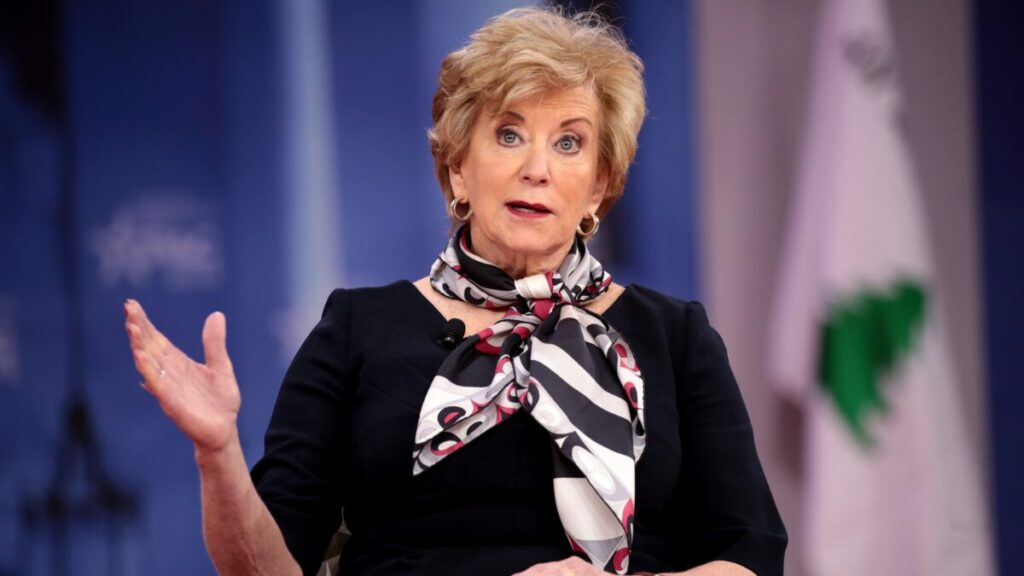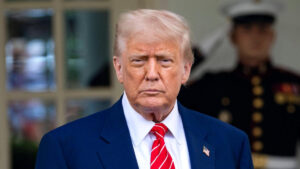In the late 1970s, Linda McMahon wasn’t a boardroom titan or political force—she was a young mother navigating bankruptcy court with her husband, Vince. The McMahons had staked everything on a dream that, at the time, looked more like a gamble: turning a regional wrestling circuit into something bigger. They were down to one car. Their utilities were sometimes shut off. And creditors were circling.
It’s a long way from that reality to the manicured wealth of 2025, where Linda McMahon’s name is now associated with billion-dollar valuations, cabinet-level appointments, and oceanfront estates. But that contrast isn’t just dramatic—it’s defining.
Linda’s story is not one of overnight success. It’s a blueprint of strategic reinvention: from running the books for a scrappy wrestling operation in Connecticut to guiding WWE’s transformation into a global media powerhouse. Each phase of her career—from entertainment to government—was built on lessons learned in survival mode.
Those early struggles forged the financial discipline and calculated risk-taking that would eventually set the McMahons apart. While Vince was the face of the ring, Linda was the architect behind the empire’s structure. Her path to fortune was less flashy, more methodical—but just as essential. Her rise wasn’t just about building wealth. It was about never letting failure be final.
The WWE Empire: How Linda Helped Turn Wrestling Into a Global Powerhouse
Executive Genius Behind the Curtain
While Vince McMahon commanded the spotlight in the ring and on camera, Linda McMahon quietly ran the show behind the scenes. As WWE’s CEO from 1997 to 2009, she wasn’t just managing operations—she was engineering a transformation. It was under Linda’s leadership that WWE shifted from a family-run wrestling promotion to a publicly traded entertainment juggernaut.
Her most defining move? Guiding WWE through its 1999 IPO. Linda led the corporate restructuring, navigated SEC filings, and positioned the company to attract institutional investors—turning a niche product into Wall Street gold. That moment didn’t just inject capital; it legitimized WWE as a mainstream media business.
But her impact didn’t stop there. Linda negotiated key licensing agreements, expanded WWE’s global broadcast footprint, and helped scale its merchandise empire—turning Superstars into global brands. She wasn’t just approving budgets; she was shaping the company’s long-term vision.
Her leadership style was disciplined, data-driven, and deeply strategic. While Vince built the show, Linda built the business. And without her, the WWE might have stayed a local spectacle instead of becoming a global phenomenon.
Family Enterprise, Strategic Brilliance
WWE has always been a family affair—but behind the glamour of pyrotechnics and pay-per-views was a tightly run enterprise where Linda McMahon played a central, often underestimated role. While Vince was the visionary showman and risk-taker, Linda brought structure, consistency, and strategic foresight that kept the wheels turning.
Together, they curated a brand that transcended generations. Linda was instrumental in refining WWE’s public image—transforming it from a controversial, niche subculture into a mainstream entertainment brand with corporate sponsors, PG-era programming, and global merchandising. Her influence helped bridge the gap between edgy wrestling content and family-friendly appeal, opening doors to broader audiences and more lucrative partnerships.
Internally, she co-managed operations with a focus on discipline and scalability. From HR protocols to talent contracts, she professionalized WWE’s infrastructure during a time of rapid growth and public scrutiny. The result wasn’t just a stronger company—it was a legacy brand.
In a male-dominated industry, Linda carved out her domain—not through force of personality, but through the quiet brilliance of sustained strategic execution.

A Political Pivot: Wealth Through Influence and Federal Leadership
From Senate Bids to Cabinet Appointments
Linda McMahon’s foray into politics began with two high-profile—and expensive—Senate runs in Connecticut. In 2010 and again in 2012, she poured nearly $100 million of her fortune into campaigns that ultimately ended in defeat. Critics questioned the value of such a hefty investment in races she couldn’t win, but in hindsight, those bids served a deeper purpose: building political capital and national visibility.
That visibility paid off in 2017 when President Donald Trump appointed her to lead the U.S. Small Business Administration. For Linda, it was a natural fit. She brought hands-on experience from scaling WWE and understood the challenges entrepreneurs face in volatile markets. During her tenure, she championed mentorship programs and simplified loan processes for small business owners—earning bipartisan respect despite her partisan path.
The lesson? In Linda’s world, even a loss can be leveraged. Her Senate campaigns didn’t win her a seat—but they won her a seat at the table.
America First Action and Political Capital
After stepping down from the SBA in 2019, Linda McMahon transitioned into a new kind of power role—one where money and influence intersect. As chair of America First Action, the primary pro-Trump super PAC, she oversaw a war chest that poured tens of millions into Republican campaigns across the country. Her position wasn’t just ceremonial—Linda became a key strategist in shaping the GOP’s fundraising ecosystem.
By leveraging her business reputation and deep pockets, she gained rare access to high-level political circles. Her donations weren’t simply contributions—they were investments in long-term influence. She became a go-to ally for candidates aligned with Trump’s agenda, and a power broker in conservative political media and donor networks.
In the world of political fundraising, Linda’s impact proved that financial power, used strategically, can translate into lasting political capital—even without holding elected office.
Business Beyond the Ring: Diversified Investments and Passive Income Streams
Though Linda McMahon’s public identity is tightly woven into wrestling and politics, much of her financial power in 2025 stems from what she’s done after the lights dimmed. Once her WWE and political chapters closed, Linda pivoted into a more discreet—but highly profitable—phase of wealth building.
At the center of her portfolio is real estate. Her Greenwich, Connecticut mansion—a sprawling estate nestled among hedge fund billionaires—is just the beginning. Over the years, she’s quietly invested in commercial properties and high-end residential developments, favoring blue-chip neighborhoods in Florida and the Northeast. These assets appreciate in the background, adding long-term value with minimal volatility.
Then there are the boardrooms. Linda has become a sought-after name for advisory boards and speaking circuits. From corporate leadership panels to entrepreneurship summits, she monetizes her experience by guiding companies navigating growth, regulation, and crisis management. Her appearances command premium fees, but more importantly, they keep her connected to key business networks.
Post-government, she’s also made forays into private equity and lobbying—areas where political and business savvy intersect. Ties forged during her SBA tenure positioned her as a bridge between entrepreneurs and policymakers. She now works quietly behind the scenes, advising on policy-impact analysis, small business legislation, and conservative-aligned investment funds.
Linda’s post-ring portfolio proves that lasting wealth isn’t just about what you build—it’s about how well you leverage your name, networks, and knowledge. While her early fortune came from televised spectacle, her current streams are built on quiet influence and strategic foresight.
Brand McMahon: Monetizing Legacy
Even after stepping away from day-to-day operations, Linda McMahon continues to profit from the empire she helped build. As WWE evolved under the new banner of TKO Holdings—a merger between WWE and UFC backed by Endeavor—legacy shareholders like Linda and Vince McMahon retained valuable equity. That means continued dividends from a company that now spans live sports, streaming, and international media.
Beyond equity, Linda benefits from licensing deals tied to the WWE brand. From archived footage to merchandise featuring the McMahon name, the royalty checks haven’t stopped. WWE’s growing partnership with platforms like Netflix, which now hosts original wrestling content and documentaries, has further enhanced the value of legacy figures, including Linda’s executive story.
Her legacy has become a monetizable asset. In many ways, she’s no longer just a business leader; she’s a character in a billion-dollar mythology—and that mythology continues to pay.
How Much Is Linda McMahon Worth in 2025? A Breakdown by Asset Class
As of 2025, Linda McMahon’s estimated net worth stands at approximately $3.2 billion, according to Times of India —a figure built on decades of strategic investments, executive leadership, and high-level political influence. But behind the headline number is a complex mosaic of asset classes that tells a richer story about how her wealth has been structured and preserved.
Her real estate portfolio remains a cornerstone, with multiple high-value properties including her Greenwich estate—estimated at over $25 million—as well as holdings in Florida and business districts across the Northeast.
She continues to earn dividends from WWE equity, both from her time pre-IPO and through retained shares in TKO Holdings, the post-merger entity created when WWE and UFC joined forces under Endeavor. These holdings represent not just nostalgia value, but real capital appreciation as combat sports go global.
Political consulting and strategic advisory roles also generate consistent income. After leading the SBA and chairing a major super PAC, Linda transitioned into quiet lobbying, offering policy insights to businesses and conservative donor networks. These channels, while less visible, provide lucrative retainers and long-term financial upside.
Linda’s wealth is notable not just for its size, but for its resilience. She’s not reliant on any single venture, but rather, a diversified ecosystem she helped engineer from scratch.

Where Linda McMahon Ranks Among Political Power Players and Wrestling Tycoons
Linda McMahon’s estimated $3.2 billion net worth in 2025 places her in rare company—especially when measured against fellow moguls in the intersecting worlds of entertainment, politics, and combat sports.
Her husband, Vince McMahon, still holds the top spot in the family fortune hierarchy, with an estimated net worth nearing $2.7 billion, bolstered by his controlling stake in TKO Holdings and decades of licensing income. Donald Trump, once her political ally and boss during her tenure at the SBA, has fluctuated in reported wealth but sits at an estimated $2.3 billion, largely driven by real estate and brand licensing.
Then there’s Dana White, UFC’s longtime president, with a net worth estimated around $500 million, and Ari Emanuel, CEO of Endeavor (now overseeing TKO), whose net worth in 2025 exceeds $450 million—but backed by controlling interest in multiple entertainment platforms.
What sets Linda apart isn’t just her portfolio—it’s her position as a woman in an ultra-male-dominated circle. The gender gap in executive net worth is still pronounced, particularly in legacy industries like sports entertainment and politics. Yet Linda’s trajectory proves that long-term strategy and behind-the-scenes power can rival even the flashiest public empires.
She may not command the headlines like Vince or Trump, but her numbers speak volumes. In a league of titans, Linda McMahon holds her own—and then some.
Linda In Her Own Words: What Wealth Means to Me
“We never imagined building a billion-dollar business out of what started in our basement. But I’ve always believed in vision, resilience, and a little bit of showmanship.”
When people ask me about wealth, I don’t immediately think of numbers—I think of moments. The nights Vince and I stayed up wondering how we’d make payroll. The first time WWE aired in a country we’d never visited. The look on our children’s faces when they saw what we’d built together. That’s what sticks.
To me, wealth isn’t about extravagance. It’s about freedom—to make decisions, to support causes we care about, to take risks without losing sleep. We’ve been fortunate to give back to education, veterans, and small businesses—communities that shaped our story.
I know public perception can be complicated. Being in business and politics opens you up to critique. But I’ve learned that legacy isn’t built in press releases. It’s built in what you leave behind—for your family, your community, and the next generation of leaders watching from the sidelines.
Success doesn’t come from perfection. It comes from persistence. And I hope that’s the part people remember.
Criticism, Controversy, and Public Scrutiny: The Cost of Political Wealth
With visibility comes scrutiny, and Linda McMahon has faced her share. Her self-funded Senate campaigns—nearly $100 million spent without a win—drew criticism from political analysts who saw them as exercises in unchecked wealth rather than civic engagement. Her time as head of the Small Business Administration also sparked debate, with detractors questioning whether her corporate background aligned with the needs of Main Street entrepreneurs.
Ties to former President Trump and her leadership of America First Action further complicated public perception. Some saw her as a savvy political operator; others viewed her as a loyalist in a polarized landscape.
Even outside politics, WWE’s history has added to the controversy. Long-standing critiques around performer treatment, independent contractor status, and workplace safety have resurfaced over the years—with Linda, as a former CEO, sometimes pulled into the narrative.
Still, she’s weathered each storm with trademark discipline—proving that wealth may open doors, but it also raises the volume of every knock.
Balancing Power and Public Image
In today’s hyper-connected world, power isn’t just exercised—it’s scrutinized. Linda McMahon has learned to navigate the tightrope between influence and perception. Whether facing partisan divides or media pushback, she’s maintained a polished, composed presence that reflects her corporate roots.
She rarely engages in public sparring, opting instead for controlled messaging and strategic silence—a reputation management style that favors long-term optics over quick wins. In the age of viral headlines and algorithm-driven outrage, Linda’s approach is old-school but effective: let results speak louder than reactions. It’s a method shaped by decades of high-stakes visibility—and practiced resilience.
What Linda McMahon’s Wealth Tells Us About Power, Reinvention, and Persistence
Linda McMahon’s wealth isn’t the product of one lucky break—it’s the result of decades of calculated ambition, relentless reinvention, and staying power in industries known for volatility. From navigating bankruptcy to overseeing a billion-dollar IPO, from cabinet meetings in D.C. to boardrooms on Wall Street, her journey reflects a rare blend of executive discipline and adaptability.
Her fortune was built across multiple arenas: the entertainment empire of WWE, savvy real estate moves, political capital, and behind-the-scenes consulting. Each phase fed the next—proof that true financial longevity comes not from flash, but from foresight.
Linda’s legacy defies simple labels. She’s a business leader, political player, and one of the few women to dominate spaces often reserved for men. Her story shows that wealth isn’t just a number—it’s a narrative. And in Linda’s case, it’s one shaped by power used purposefully, and persistence exercised with precision.
Mohit is a finance and entertainment writer specializing in celebrity wealth, brand strategy, and media empires. As Co-Founder of TheNetWorths.com, he brings over a decade of experience analyzing public income streams, endorsement deals, and the evolving creator economy.

















3 thoughts on “Linda McMahon Net Worth 2025: How She Built a $3.2 Billion Fortune From Wrestling to Washington”